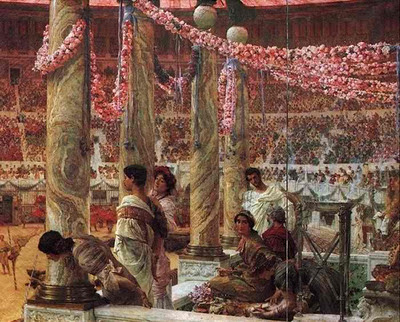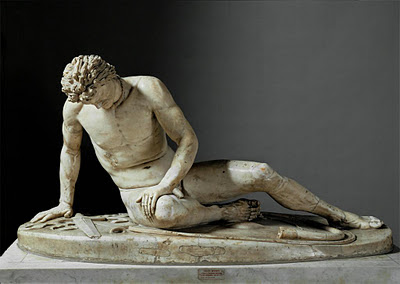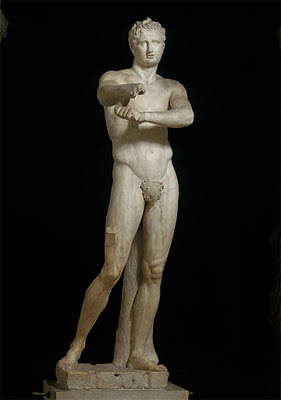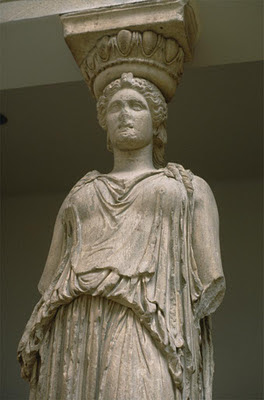On View
A Melting Pot at the Intersection of Empires for Five Centuries
By JOHN NOBLE WILFORD
Published: December 19, 2011
In its time and place, the ancient city of Dura-Europos had much in common with today’s most cosmopolitan urban landscapes. Religious, linguistic and cultural diversity characterized much of the city’s life for more than 500 years, starting at the outset of the third century B.C. in what is now Syria.
Yale University Art Gallery
The discovery of antiquity's best preserved synagogue brought attention to the excavations of Dura-Europos.
Multimedia
Greek, Aramaic, Latin, Parthian, Middle Persian and Hebrew — all of these languages were used concurrently throughout the society, according to inscriptions and graffiti uncovered by archaeologists. A temple altar epitomizes the multiculturalism: The inscription is in Greek, and a man with a Latin name and a Greek-titled office in the Roman army is shown presenting an offering to Iarhibol, a god of the migrants from the old Syrian caravan city of Palmyra.
New Yorkers would have felt at home in the grid pattern of streets, where merchants lived, scribes wrote and Jews worshiped in the same block, not far from a Christian house-church as well as shrines to Greek and Palmyrene deities. Scholars said the different religious groups seemed to maintain their distinct identities.
An exhibition of prized and quotidian artifacts from Dura-Europos, “Edge of Empires: Pagans, Jews, and Christians at Roman Dura-Europos,” is on view through Jan. 8 at New York University’s Institute for the Study of the Ancient World. The objects — notably art from antiquity’s best-preserved synagogue, and evocative photographs of the buried city’s excavations — are on loan from the Yale University Art Gallery.
“As a city of extraordinary cultural diversity,” said Jennifer Y. Chi, an archaeologist and the exhibition’s chief curator, “Dura-Europos has great resonance for the modern world, where multiculturalism shapes the very nature and quality of daily life.”
Macedonian successors to Alexander the Great founded Dura-Europos on a plateau high above the Euphrates River. The precipitous drop to the river and deep ravines made the city virtually invulnerable on three sides; stone fortifications faced the desert to the west. “It was beautifully made by nature as a fortress town,” said Glen W. Bowersock, an authority on the late antiquity period at the Institute for Advanced Study in Princeton, N.J.
There the city stood at the intersection of empires for five centuries. The Greeks named it Europos, after the hometown of its founders, and built it around an eight-block agora, the political and commercial center typical of any Greek city. When the stone wall was erected, “Dura,” the Assyrian term for a fortified city, was added.
Parthians from the Caspian Sea region took over in the late second century B.C. Romans seized it as the eastern outpost of their empire in A.D. 165, but about 100 years later, the Sasanians from Persia laid siege to the city and destroyed it.
Dura-Europos was never rebuilt. Its ruins were soon buried under desert sands, to be discovered in 1920 by British soldiers digging a trench. By the late 1930s archaeologists, including a Yale team led by Michael Rostovtzeff, exposed at least a quarter of the city. The excavations opened scholars’ eyes to the art and architecture of a thriving multiethnic city of perhaps 10,000 people.
As it happened, the soldiers dug into wall paintings in what turned out to be the Temple of the Palmyrene Gods, or Temple of Bel, the first of several spectacular finds.
The discoveries of the synagogue and the Christian place of worship during the Roman period brought international attention to the excavations. Although more recent digs have more than doubled the area examined, the exhibition focuses on the earlier findings and the years the city was a Roman military base.
The synagogue, built on the western edge of the city after the Roman conquest, was an impressive building, the high walls of its main hall painted with biblical scenes: the infancy of Moses, the Exodus, the sacrifice of Elijah and more than 50 other events. All the paintings are seen in the digital slide show at the exhibition, and 10 painted tiles from the ceiling are on display for the first time as a group. (The most complete reconstruction of the synagogue is in the Damascus Museum.)
The elaborate decorations were a surprise to some scholars, for the paintings offered proof that figural representation in a Jewish religious setting was not anathema at this time in history, despite the Mosaic commandment against graven images.
The building that is said to be the earliest surviving Christian “house of the church” was much less impressive, for good reason. At the time, the religion was officially banned in the Roman empire (it was 325 before Emperor Constantine endorsed Christianity), and the faithful met in secret, often in private houses. On the outside, the house-church in Dura-Europos looked like other residences on the block. Inside, paintings from the baptistery illustrated the miracles of Jesus and the procession of women in the baptism ritual.
The Roman military culture also contributed to the city’s diversity. Troops were recruited from all parts of the empire, a polyglot mix from northern Europe to the Mediterranean and beyond. Several Celtic bronze belt ornaments and horse-harness pieces in the show call attention to international influences. Uncovered from the ruins was a shrine to the god Mithras, a deity favored by soldiers.
At the entrance to one of the galleries stands a Roman military shield, or scutum, a semicylindrical piece made of wood and rawhide that a soldier held in front of him for head-to-toe protection. Nothing olive drab about this military gear, handsomely painted in high imperial style.
Through the centuries, one culture after another left its imprint on Dura-Europos. As Dr. Bowersock pointed out, even if Romans issued military orders in Latin, the clerks and shopkeepers spoke Aramaic, and many people in the street kept their native tongues, the principal language of government and culture remained the Greek of its founders.
New Yorkers would have felt at home in the grid pattern of streets, where merchants lived, scribes wrote and Jews worshiped in the same block, not far from a Christian house-church as well as shrines to Greek and Palmyrene deities. Scholars said the different religious groups seemed to maintain their distinct identities.
An exhibition of prized and quotidian artifacts from Dura-Europos, “Edge of Empires: Pagans, Jews, and Christians at Roman Dura-Europos,” is on view through Jan. 8 at New York University’s Institute for the Study of the Ancient World. The objects — notably art from antiquity’s best-preserved synagogue, and evocative photographs of the buried city’s excavations — are on loan from the Yale University Art Gallery.
“As a city of extraordinary cultural diversity,” said Jennifer Y. Chi, an archaeologist and the exhibition’s chief curator, “Dura-Europos has great resonance for the modern world, where multiculturalism shapes the very nature and quality of daily life.”
Macedonian successors to Alexander the Great founded Dura-Europos on a plateau high above the Euphrates River. The precipitous drop to the river and deep ravines made the city virtually invulnerable on three sides; stone fortifications faced the desert to the west. “It was beautifully made by nature as a fortress town,” said Glen W. Bowersock, an authority on the late antiquity period at the Institute for Advanced Study in Princeton, N.J.
There the city stood at the intersection of empires for five centuries. The Greeks named it Europos, after the hometown of its founders, and built it around an eight-block agora, the political and commercial center typical of any Greek city. When the stone wall was erected, “Dura,” the Assyrian term for a fortified city, was added.
Parthians from the Caspian Sea region took over in the late second century B.C. Romans seized it as the eastern outpost of their empire in A.D. 165, but about 100 years later, the Sasanians from Persia laid siege to the city and destroyed it.
Dura-Europos was never rebuilt. Its ruins were soon buried under desert sands, to be discovered in 1920 by British soldiers digging a trench. By the late 1930s archaeologists, including a Yale team led by Michael Rostovtzeff, exposed at least a quarter of the city. The excavations opened scholars’ eyes to the art and architecture of a thriving multiethnic city of perhaps 10,000 people.
As it happened, the soldiers dug into wall paintings in what turned out to be the Temple of the Palmyrene Gods, or Temple of Bel, the first of several spectacular finds.
The discoveries of the synagogue and the Christian place of worship during the Roman period brought international attention to the excavations. Although more recent digs have more than doubled the area examined, the exhibition focuses on the earlier findings and the years the city was a Roman military base.
The synagogue, built on the western edge of the city after the Roman conquest, was an impressive building, the high walls of its main hall painted with biblical scenes: the infancy of Moses, the Exodus, the sacrifice of Elijah and more than 50 other events. All the paintings are seen in the digital slide show at the exhibition, and 10 painted tiles from the ceiling are on display for the first time as a group. (The most complete reconstruction of the synagogue is in the Damascus Museum.)
The elaborate decorations were a surprise to some scholars, for the paintings offered proof that figural representation in a Jewish religious setting was not anathema at this time in history, despite the Mosaic commandment against graven images.
The building that is said to be the earliest surviving Christian “house of the church” was much less impressive, for good reason. At the time, the religion was officially banned in the Roman empire (it was 325 before Emperor Constantine endorsed Christianity), and the faithful met in secret, often in private houses. On the outside, the house-church in Dura-Europos looked like other residences on the block. Inside, paintings from the baptistery illustrated the miracles of Jesus and the procession of women in the baptism ritual.
The Roman military culture also contributed to the city’s diversity. Troops were recruited from all parts of the empire, a polyglot mix from northern Europe to the Mediterranean and beyond. Several Celtic bronze belt ornaments and horse-harness pieces in the show call attention to international influences. Uncovered from the ruins was a shrine to the god Mithras, a deity favored by soldiers.
At the entrance to one of the galleries stands a Roman military shield, or scutum, a semicylindrical piece made of wood and rawhide that a soldier held in front of him for head-to-toe protection. Nothing olive drab about this military gear, handsomely painted in high imperial style.
Through the centuries, one culture after another left its imprint on Dura-Europos. As Dr. Bowersock pointed out, even if Romans issued military orders in Latin, the clerks and shopkeepers spoke Aramaic, and many people in the street kept their native tongues, the principal language of government and culture remained the Greek of its founders.

















 CreatorApollonios of Athens ?CultureGreekTitlePugilist Reposing (Wrestler; Seated Boxer); A Hellenistic Sovereign or Warrior [rear]Work TypesculptureDatec. 50 BCMaterialbronzeMeasurementsPugilist, height: 128 cmStyle PeriodGreco-RomanDescriptionboth works found in the foundations of the National Dramatic Theatre in Via Nazionale, RomeRepositoryMuseo nazionale romano
CreatorApollonios of Athens ?CultureGreekTitlePugilist Reposing (Wrestler; Seated Boxer); A Hellenistic Sovereign or Warrior [rear]Work TypesculptureDatec. 50 BCMaterialbronzeMeasurementsPugilist, height: 128 cmStyle PeriodGreco-RomanDescriptionboth works found in the foundations of the National Dramatic Theatre in Via Nazionale, RomeRepositoryMuseo nazionale romano

















 TitleAthens (Acropolis): Parthenon: Ext.: East - Stylobate & CrepidomaDate447-436LocationAthens (Greece)
TitleAthens (Acropolis): Parthenon: Ext.: East - Stylobate & CrepidomaDate447-436LocationAthens (Greece)











